Wagner cast iron cookware is regarded by many as some of the finest examples of 19th and 20th century cast iron. Much of the cast iron is over 100 years old and still usable today. These antique pans are sought-after by enthusiasts who prefer vintage cast iron to newer pans. But identifying and dating these old Wagner Ware Sidney -o-pans can be tricky.
So, with this article, I hope to help you and other proud owners identify and give an estimate of the age of your cookware. You can also learn the history of your cast iron, which the Wagner Manufacturing Company manufactured.
Table Of Contents
- Wagner cast iron. “Why is it so collectible?”
- Learn the history of the Wagner Manufacturing Company.
- Where you can buy Wagner cast iron.
- Considerations when purchasing Wagner cast iron cookware.
- You can identify and date antique Wagner cast iron using trademarks and logos.
- Final thoughts on collecting vintage Wagner Ware cast iron.
But first, here is a quick look at the Wagner Manufacturing Company.
Identify And Date Your Wagner Cast Iron Skillets Using Logos. Also, Learn The Fascinating History Of Wagner Manufacturing.
Background To Wagner Manufacturing Cast Iron.
Founders | Milton M. Wagner and Bernard P. Wagner |
Operational Dates | The foundry in Sidney operated from 1891-1959 |
Located | The Wagner Manufacturing foundry was in Sidney, Shelby County, Ohio. |
Product Line | Wagner was one of the largest American manufacturers of cast iron products in the 20th century. Their product line included skillets, kettles, bean pots, Dutch Ovens, roasters, fruit presses, scoops, broilers, Griddles, waffle irons, muffin pans, and cornbread pans. The company also had a range of aluminum cookware. |
Wagner Brands | Wagner labeled their cookware under the following names: Wagner, Wagner Ware Sidney -o-, Wagner Ware, National, Long Life, Magnalite, Wardway, and Ward’s Cast Iron. |
Signature Products | Wagner is best known for the Sidney -O- range of skillets and Dutch Ovens. |
Reason For Closure | The reason for the closure of the foundry came from two fronts. Firstly, the Wagner family sold their interests in the company in 1953 to the Randell Company. Secondly, the company struggled financially because of a drop in sales. The decline in sales was due to two World Wars, the Great Depression, the development of new cookware materials, and the increase of lower-priced imports from Asia |
Wagner After Buyout (Non-Collectible) | In 1957, the Randall Company purchased long-term competitor Griswold from McGraw Edison. The Randall Company sold the cast iron businesses to Textron Corp in 1959. General Housewares Corporation bought Textron in 1969. In 1994, the production of Wagner Ware ended. |
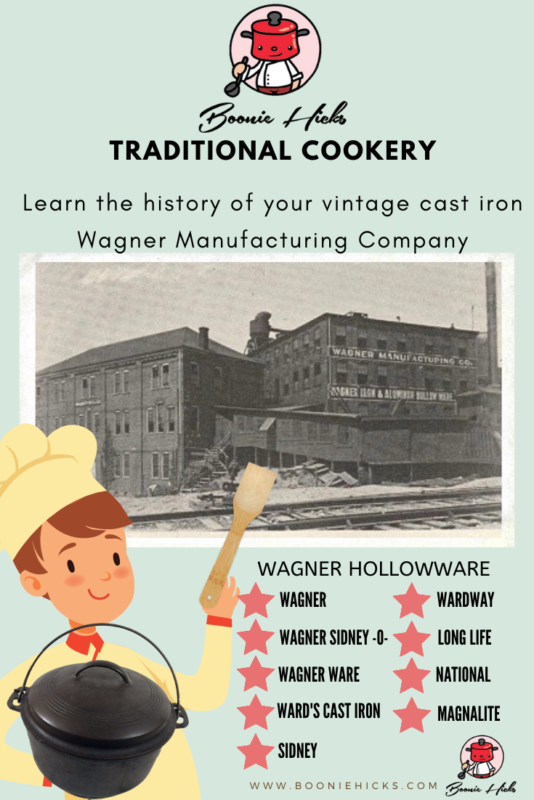
Why Is Wagner Cast Iron Collectible?
Super Smooth Cooking Surface.
Wagner cast iron is highly collectible. Like most antique cast iron, Wagner manufactured high-quality cookware for their entire range of cast iron products.
Unlike Wapak cast iron ironware, it often has characteristic casting flaws. Wagner cast iron tends to have a few casting flaws, resulting in very smooth cookware on both the interior and exterior of the cookware.
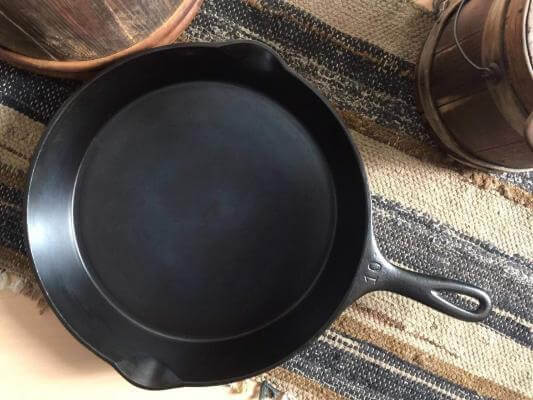
Focus On Quality
Imagine that workers would have worked on individual pieces of ironware. It was machined to smooth the interior and exterior of each pan. You can only see this level of detail in high-end cast iron cookware such as Le Creuset and Staub.
Today, Le Creuset and Staub benefit from combining traditional and modern manufacturing methods. However, the workers at Wagner could make cast iron cookware without casting flaws or bubbles. Must have taken great skill and attention to detail.
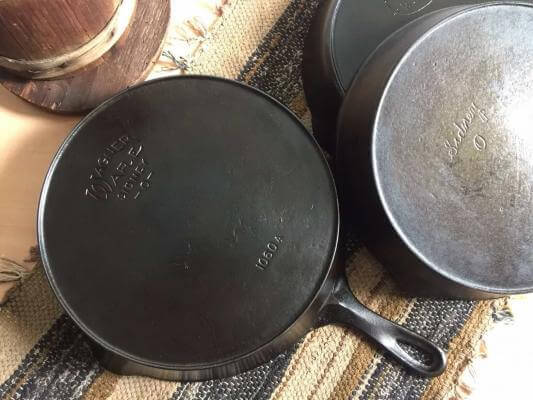
Wagner Made A Wide Range Of Cast Iron Cookware.
You can’t go wrong with an old Wagner cast iron skillet. It will serve you well for years, and they’re great fun. However, you may want to consider a Wagner Dutch oven. They are super smooth, and just like the skillets, they are reasonably priced. You can also buy cast iron muffin pans, which can be pretty cheap. But watch out for shipping costs that can increase the overall price drastically. Some of Wagner cast-iron cookware range includes:
- Dutch ovens
- Griddles
- Gem pans
- Waffle irons
- Skillets
You can even collect Wagner cast iron cornbread pans that look like corn cobs. Wagner Manufacturing also produced aluminum cookware, which must have seemed revolutionary.
Collect Your Favorite Logo.
If you want a vintage skillet, then Wagner skillets are a great choice. You can choose from sixteen different logos and trademarks or markings. I like pans with heat rings, while others may prefer a pan with a smooth base.
I think this wide selection makes Wagner cookware more collectible than other manufacturers, such as Vollrath and Martin Stove and Range, which manufacture a limited range of products.
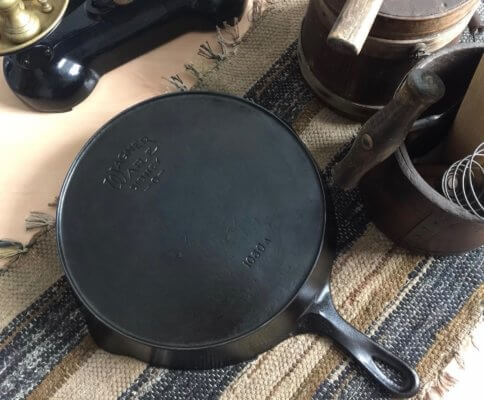
Wagner Manufacturing Company Focused On Quality Over Quantity.
Quality was a focus from the very start for Wagner Manufacturing Company. They even advertised this selling point to consumers. Old advertisements read;
We do not strive to manufacture hollowware as cheaply as possible but as well as it can be made. We cannot afford to put on the market ware that will not sustain our reputation. The name Wagner is on the bottom of each piece of ware.
Wagner Manufacturing Company History
Founders And Foundry
Who Founded Wagner Manufacturing? | Wagner Manufacturing Company was founded in 1891 by Milton M. and Bernard P. Wagner. However, two more Wagner brothers, Louis and William Wagner, joined the company in the following years. Another key player in the foundation of the company was R. Bingham. Bingham previously worked at Marion Stove Company and the Sidney Manufacturing Company. |
Where Was Wagner Cast Iron And Wagner Ware Made? | The company had its ironworks in Sidney, Shelby County, Ohio. Early cookware from Wagner Manufacturing had a simple Wagner marking on the back of the ironware. Wagner included Sidney O. in their cookware around 1895. The term Wagner Ware first appeared in the logo in the 1920s. |
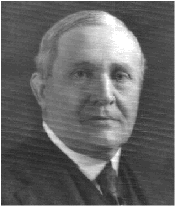
The Wagner Product Line Added Nickel Plating, Aluminum, And Magnalite.
Nickel-Plated Cast Iron | To complement their cast iron range, Wagner added a nickel-plated range. Unlike cast iron and copper pots, nickel plating does not react to acidic foods such as tomatoes, which can taint food. It’s easy to look past the development of nickel-plating. But, in the 19th century, bonding two metals together would have required much metal casting expertise. |
Aluminum Cookware | Along with nickel-plated cast iron, the Wagner brothers in 1894 manufactured a line of aluminum cookware, and Wagner Manufacturing was one of the first companies to do so. |
| Aluminum Cookware Exported To Europe | By 1913, Wagner cast iron and aluminum products were selling in Europe. |
| Magnalite | In the 1930s, Wagner manufactured a cookware line with a patented aluminum alloy called Magnalite. |
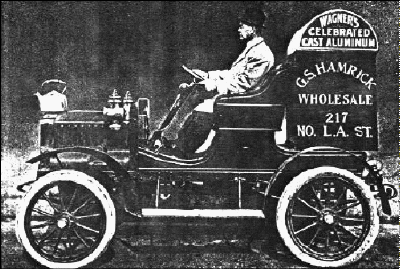
Wagner Manufacturing Buys Their Sidney Competition.
| Wagner Bought Sidney Hollowware Company. | In 1897, Wagner bought the Sidney-based competitor Sidney Hollow Ware Co. from the founder and owner Phillip Smith. Sidney Hollow Ware made high-quality cast iron cookware that was extremely light and smooth. Sidney Hollow Ware Co. was also an early adopter of nickel-plating cast iron. |
Why Did Wagner Buy Sidney Hollow Ware Company? | It was a brilliant idea to buy the Sidney Hollow Ware Company. After all, Wagner Manufacturing and Sidney competed in the same city and made comparable products. However, it was common knowledge that Smith made a tidy profit from his original investment in the foundry. To run the Sidney Foundry, William H. Wagner joined the family business to oversee the operation. |
Wagner Sold Sidney Hollow Ware Back To Phillip Smith. | In 1903, Wagner Manufacturing sold the Sidney Hollow Ware Company to the founder, Phillip Smith. Sadly, Phillip Smith did not reopen the foundry due to health reasons. |
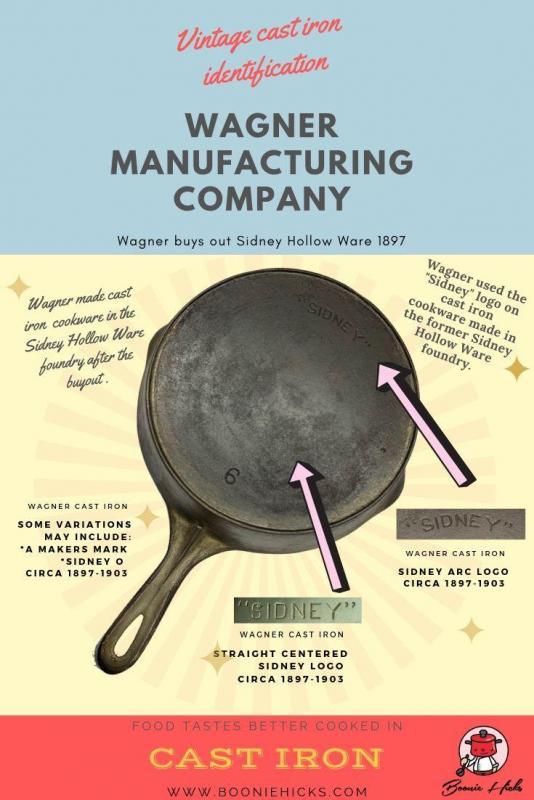
Wagner Introduced A New Product Line To Stop A Decline In Sales.
| The Great Depression (Magnalite) | I have to take my hats off to Wagner because they introduced a new product line called Magnalite in one of the deepest recessions the world has ever seen. Wagner Manufacturing was steadfast in making only quality products. For this reason, the cookware is collected and highly usable. |
| The Sales Decline | Wagner introduced Magnalite to stop falling sales at Wagner Manufacturing; it was not due to their product range. Magnalite was hugely popular, but it could not offset the effect of the worldwide recession. From 1929-1941, the US was in the grips of what we now call the Great Depression. Therefore, it was not only Wagner. However, many foundries struggled financially to survive. Many didn’t. |
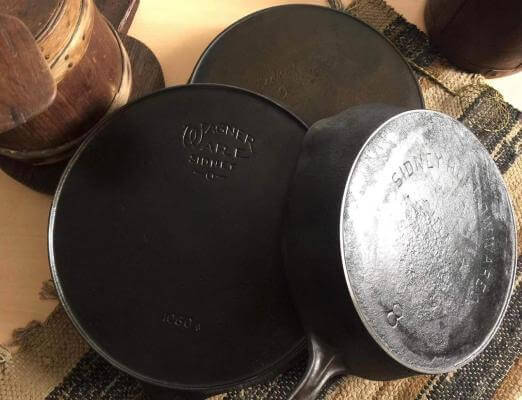
The Family Sells Their Interest In The Foundry.
Wagner Family Sells The Company To Randall Corp. | Wagner Manufacturing Co. lasted longer than many foundries. However, in 1952, Wagner was sold to the Randall Company. Unbelievably, the Randall Company was a car parts manufacturer. |
Textron Buys Randall | In 1959, another business called Tetron bought Wagner. Textron also purchases Griswold Manufacturing Company. At this date, cast iron enthusiasts consider this the end of Wagner Ware production. Wagner cast iron pans made after this date are considered not collectible. |
General House Wares | General Housewares Corporation in 1969 bought the rights of Griswold and Wagner. |
Is Wagner Ware Still Made? | With the world rediscovering cast iron cookware, will we see Wagner Ware skillets manufactured again? General Houses Ware stopped the manufacture of Wagner Ware in 1994. However, there is a glimmer of hope for Wagner Ware. In 2014, American Culinary bought both the Wagner and Griswold trademarks. So, fingers crossed, cast-iron fans may one day decide to manufacture Wagner cast iron again. |
Where Can You Get Your Hands On Some Wagner Ware?
- Grandparents (best deal and great to keep your heritage in the family).
- Antique stores (check online to compare the store price).
- Garage sales (rescue those poor skillets from the tip).
- Flea markets (search the markets for hidden gems).
- Online (largest selection available; however, asking prices can vary greatly.
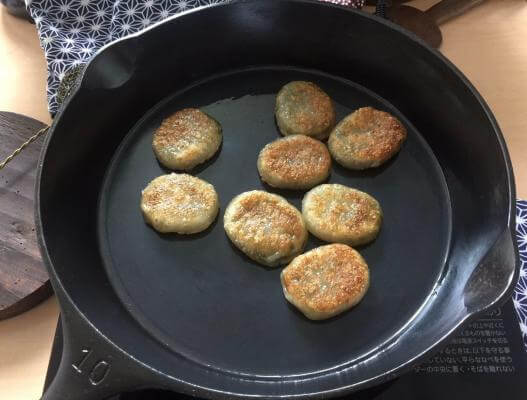
Buying Considerations Before You Buy Antique Wagner Ware
There Is Plenty Of Wagner Cast Iron Around, So Take Your Time.
There is no shortage of Wagner cast iron. Wagner had a large percentage of the cookware market back in its heyday. And plenty of fantastic Wagner skillets and Dutch ovens are in excellent condition.
What Size Skillet Or Dutch Oven Suits Your Needs?
The first thing you may want to think about is the size you need. There are often plenty of #8 skillets around. This size seems to be the most common for Wagner skillets and other vintage cast iron manufacturers, such as Favorite Piqua.
Inspect Carefully Since A Lot Of Wagner Ware Is Nickel-Plated.
Check the cookware carefully. The Wagner Manufacturing Company was an early adopter of nickel plating. However, most of Wagner cookware is unplated iron. Heavy seasoning may hide nickel plating. Nickel-plated can wear off or be patchy in places. Take a close look before purchasing.
Would You Like A Wagner Ware Skillet With A Smooth Bottom Or Heat Ring?
Do you want a pan with a smooth bottom or one with a heat ring? The older Wagner Ware skillets will have a heat ring, while the later-made pans have a smooth, flat base. It is a personal preference. I tend to like the older skillets with heat rings. They have more character, but the smooth-bottom Wagner cookware tends to be a little cheaper. And they are great cooking pans, too.
Does The Cookware Sit Flat?
As with all antique cast iron, asking the seller if the pan sits flat could be a good idea. A lever base is practical if cooking on a flat surface such as induction or glass.
Learn To Date And Identify Your Wagner Cast Iron Using Logos And Markings.
Although I’ve researched carefully, please only use the dates as an approximation.
Wagner cast iron cookware, to my knowledge, has sixteen known logos, brands, or markings. These include:
Straight Wagner Logo 1890s-1915
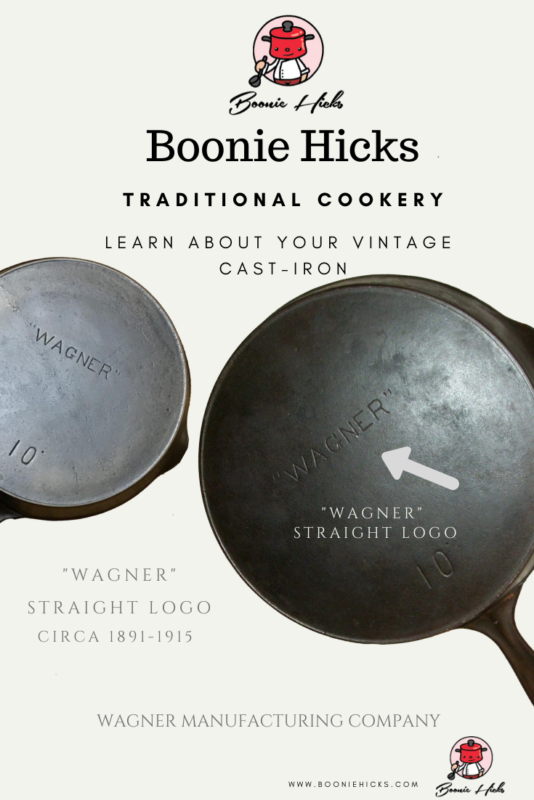
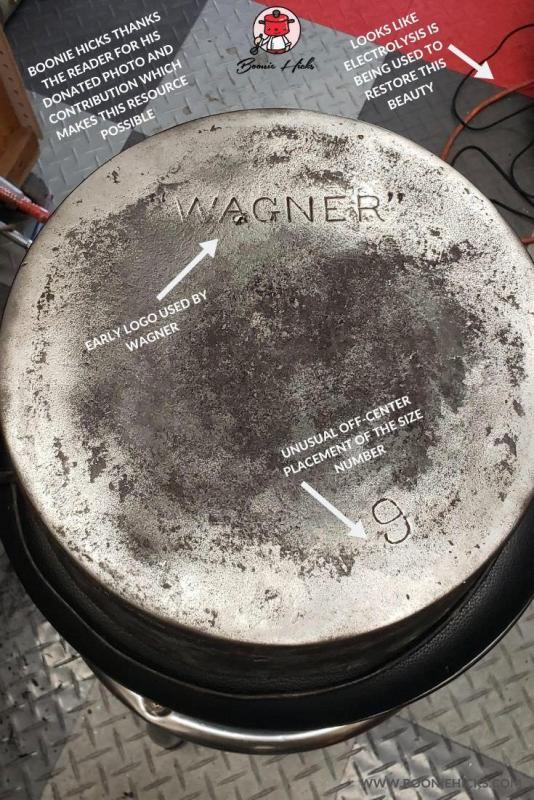
Wagner Arc Logo 1891-1910
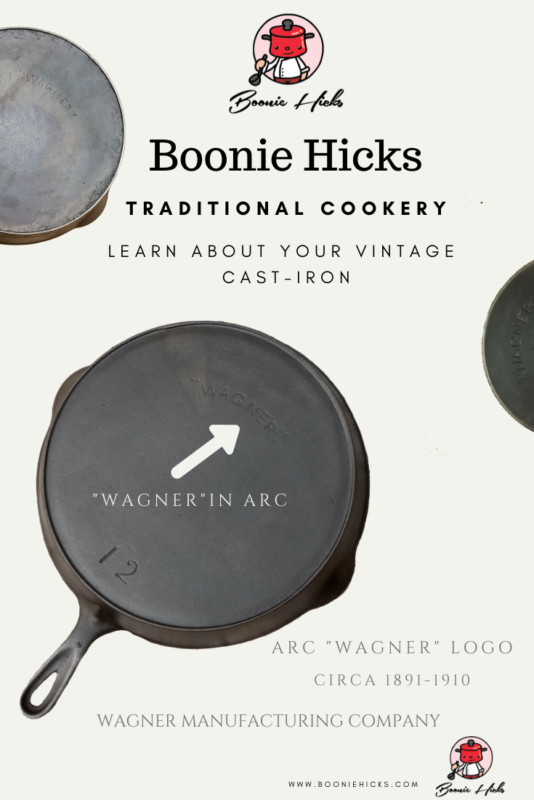

Double Arc Wagner Sidney O 1895-1915
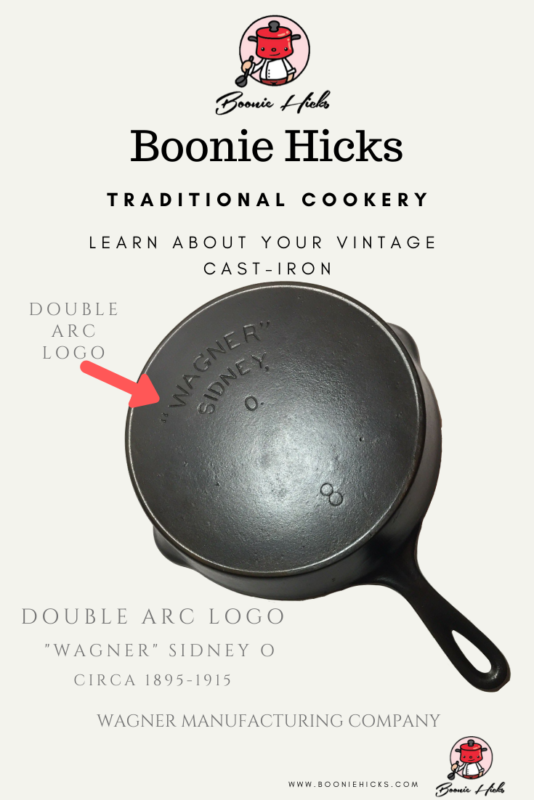
Sidney Arc logo Circa 1897-1903.
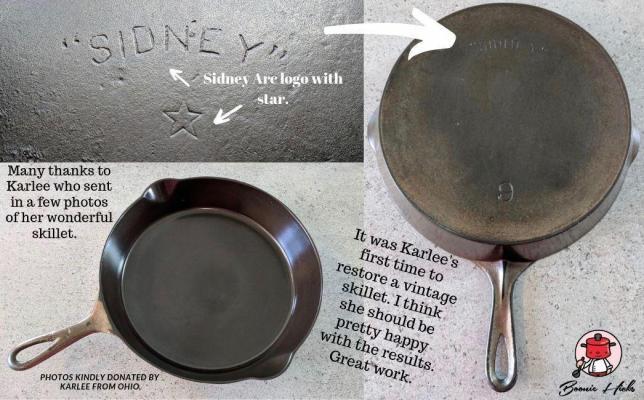
Straight Sidney Logo Circa 1897-1903.
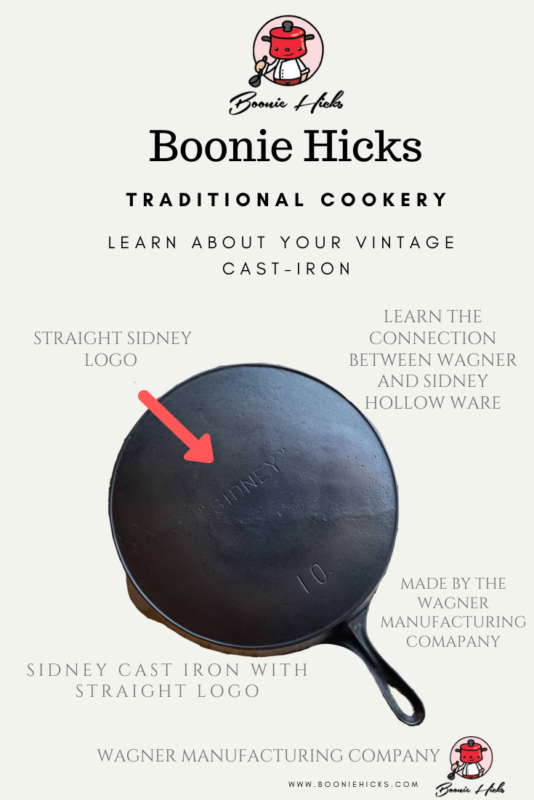
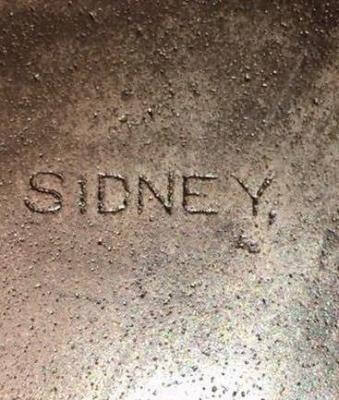
Straight Wagner Sidney O. (Centered.) 1910-1915
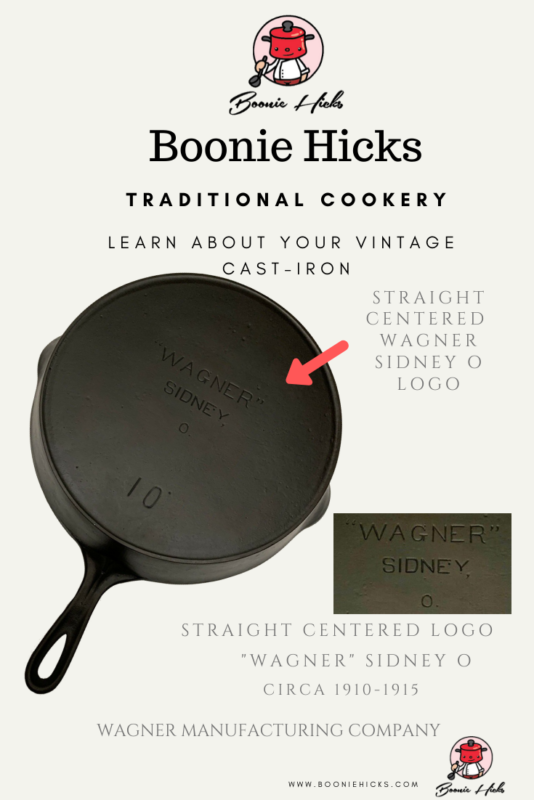
Wagner Sidney O. Wagner Slightly Arced While The Sidney Lettering Is Straight. Circa 1915-1920s
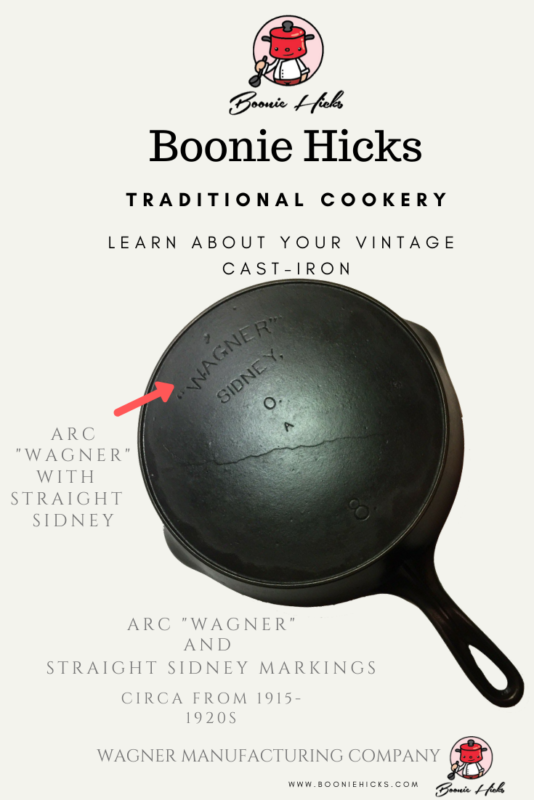
First Wagner Ware Sidney O. With Arc Wagner And Straight Ware And Sidney. Circa 1920s.
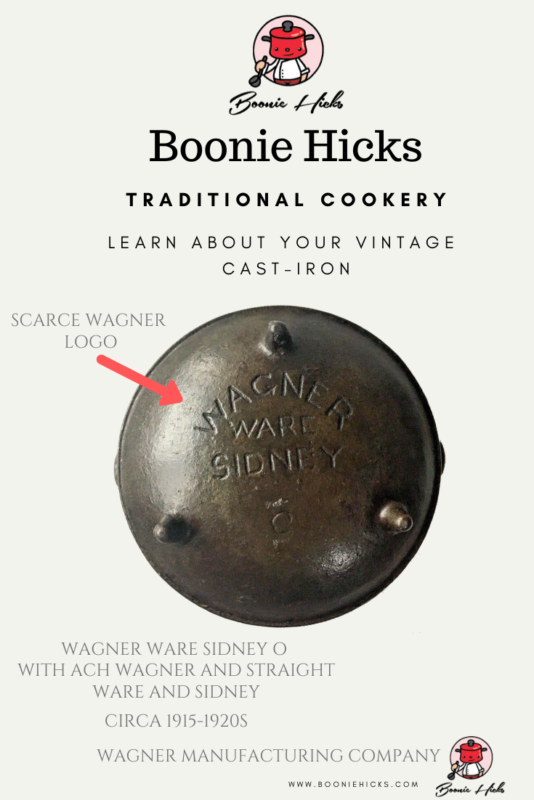
Stylized Wagner Ware Sidney O. for regular skillets. Circa 1920-1924 with heat ring and single-digit size number. 1924-1935 with a heat ring and a four-digit pattern number. Around 1935-1959, for skillets with no heat ring.
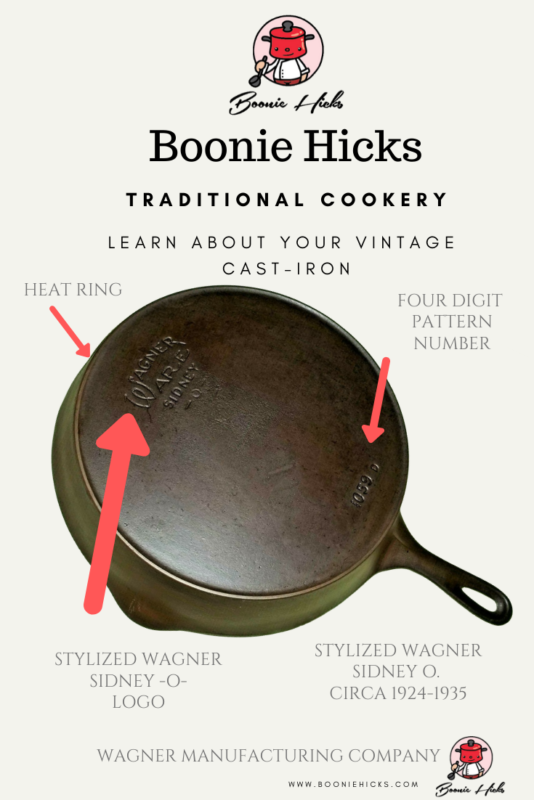
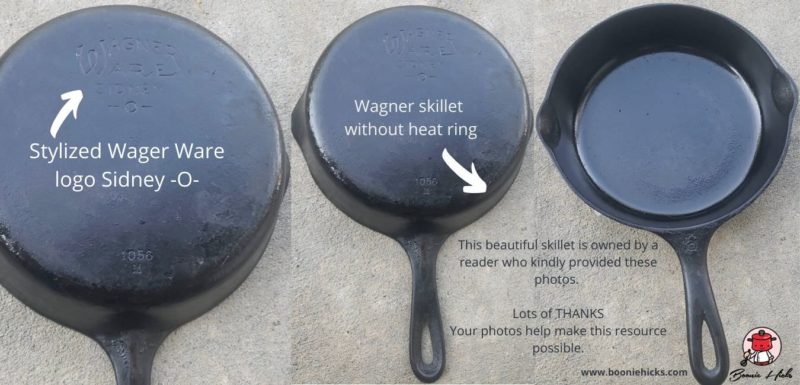
Centralized Stylized Wagner Sidney O. 1924-1935 With Heat Ring.
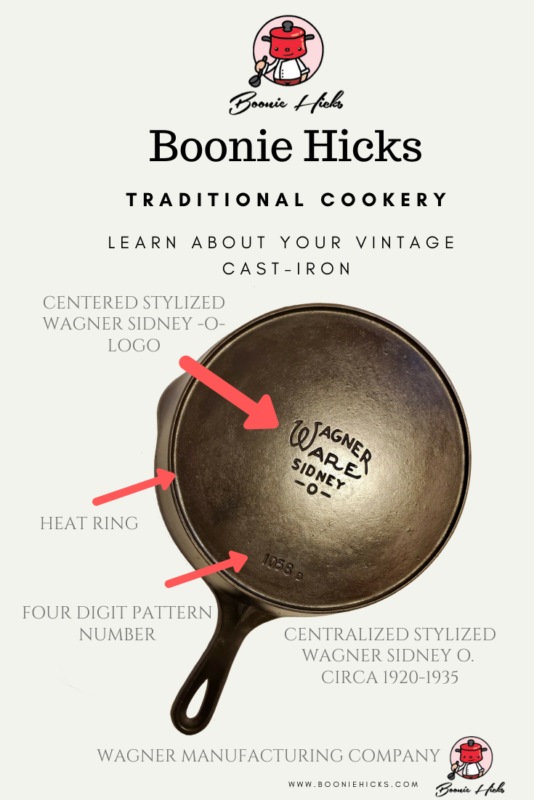
Pie Logo 1924-1934. However, Manufacturing Dates Are Uncertain.
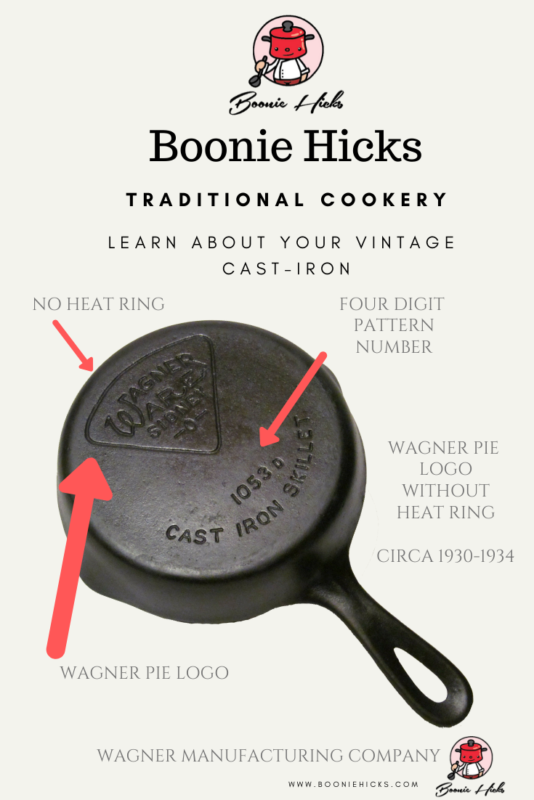
National Cast Iron Dates Between 1914 and 1940s
There are several different versions of cast iron with the National marking. Wanger marketed the Nation brand as entry-level cookware for budget-conscious consumers. Wagner made the National line circa 1914 to 1940.
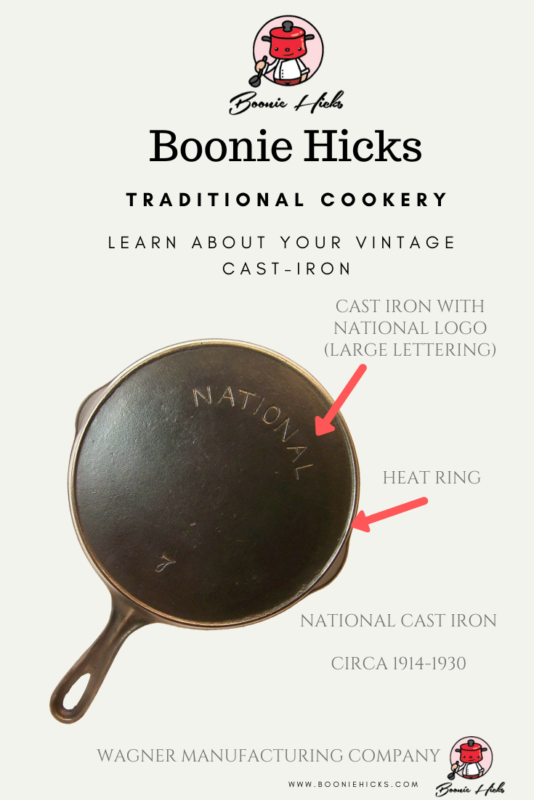
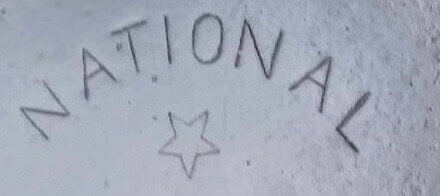
Long Life Logo 1930s.
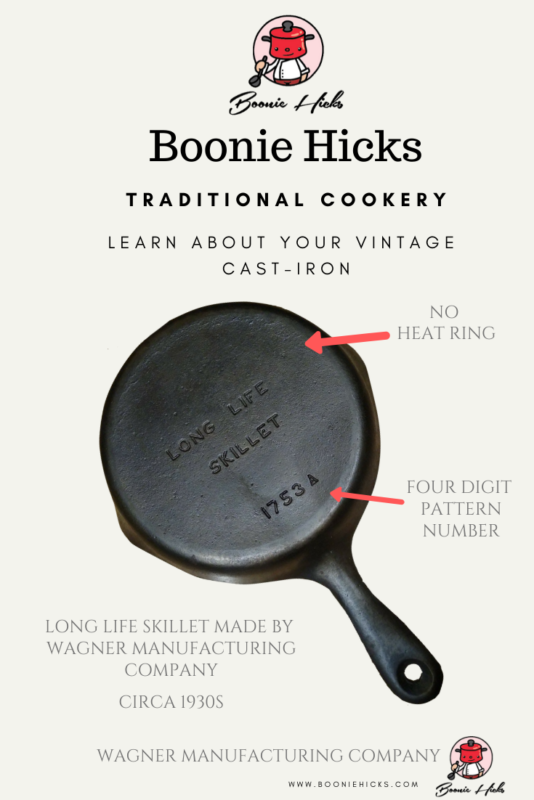
Wardway and Montgomery Ward. The Montgomery Ward Department store contracted Wagner Manufacturing Company to produce an in-store label. Circa the 1930s.
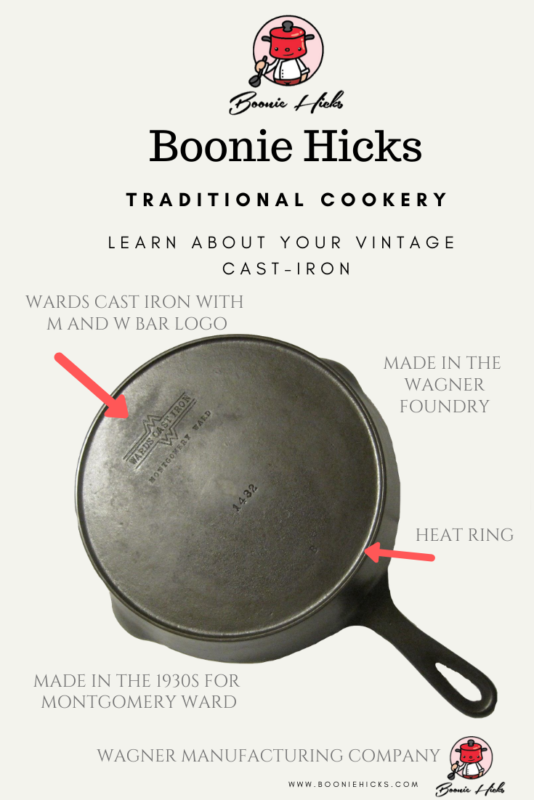
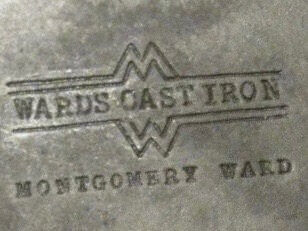
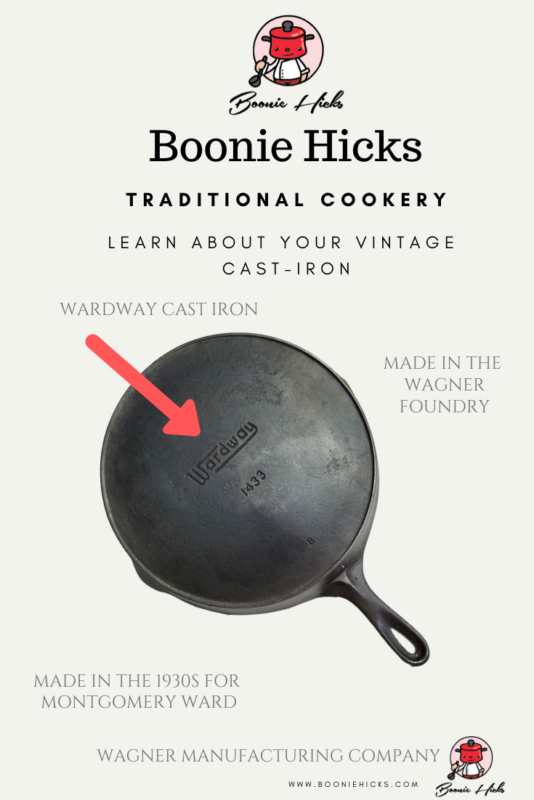
Final Thoughts On Wagner Cast Iron.
Fortunately, Wagner cast iron is more straightforward to date than other foundries of the time. Wagner Ware also has a huge collector base, so dates are well documented. The Cast Iron Collector is a valuable online resource for enthusiasts. Also, there are Facebook groups where you can share your love of cast iron cookware.
The Wagner Manufacturing Company was known for quality over quantity. Therefore, it has a good reputation for making trustworthy products.
Today, collectors and enthusiasts seek out Wagner cookware. However, you don’t need to be a collector to enjoy vintage cast iron. Here are six reasons why Wagner Ware is excellent ironware.
Although many cast iron enthusiasts look for Wagner-made skillets. But you’re not limited there. Wagner Manufactures a wide selection of cast iron cookware. You may find yourself becoming interested in:
- muffin pans
- Dutch ovens
- Scotch bowls
Since Wagner made some of the finest cast iron of the 19th and 20th centuries, Wagner ironware is still sought-after by cast-iron fans and hobbyists alike.

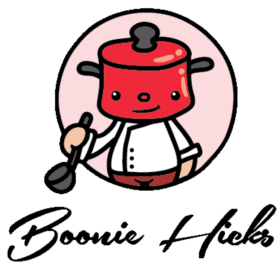
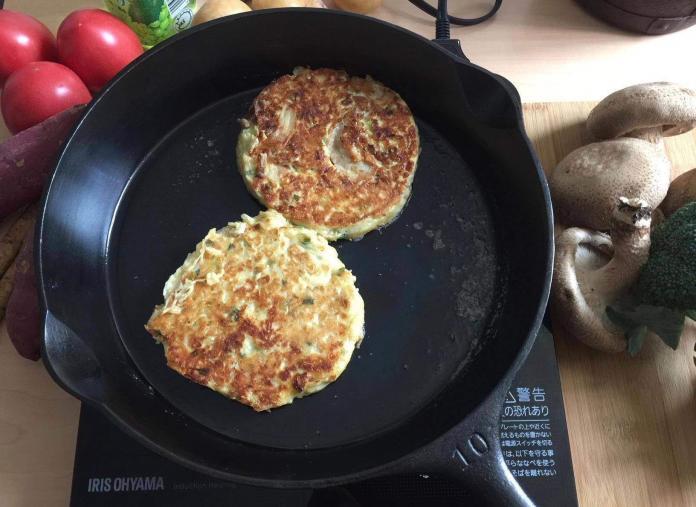
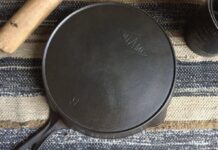
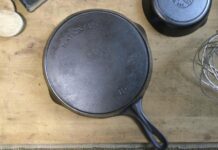
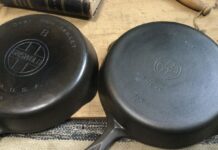



I have a Wagner Ware skillet Sidney O no heat ring. I got it from my grandmother on the back it has d1060P what are these numbers if you know thanks.
Hi Jay, thanks for getting in touch.
The number in your grandmother’s skillet is somewhat unusual. The four-digit number is known as a pattern or a catalog number by collectors, indicating the type of ironware and size. In your case, a regular cast iron size ten skillet.
The letter preceding the four-digit number stumps me and is something I haven’t seen. A capital letter usually comes directly after the number and indicates the mold to make your skillet.
Is it clearly defined as the other lettering? I am wondering if it is a shift in the mold during casting. I’m unsure about the small d on your skillet, but this makes collecting fun.
P.S. Thanks for the Facebook follow.
Hi! I found a straight logo Wagner cast iron at an antique store. It just says Wagner, and D below that (looks more like a D than an O), size 8. There is a heat ring. I’ve seen a lot photos of the arc logo or the Wagner Sidney logos, but not much of the straight logos. I’m guessing it’s early 1900?
Hi Maranda
It sounds like you’ve found an early Wagner Skillet. The straight block logo is one of the first Wagner logos and was likely made between 1891 and 1915. So, the early 1900s is a high probability.
Enjoy your skillet.
Hello, I found a Wagner Ware Sydney 3 skillet in a thrift store for $4.00.
On the bottom is the arched Wagner with the flat Ware, sharing the W. below is Sydney and then -O- .
upside down from that is an etched wolf and mountain scene.
The run number is 1053T, there is no heat ring. I have found a lot of Lodge and a few others of varying years at thrift stores, but this is my first Wagner. But I have no idea about its date.
Hi Tim
It sounds like your skillet has a stylized logo. So, it’s around 1935 to 1959 if I’ve guessed the correct marking. But please match using the images in the guide for confirmation. If your skillet has Made In Yhe U.S.A. on the bottom it’s more likely 1960s to 1970s. The wolf and mountain scene is unusual. I suspect this was added later by a previous owner.
Four dollars is a great deal. Congratulations.
I have a 9 inch unmarked chef skillet which I believed to be Wagner Ware from the 1960s. I have seen several online which have either an x or z on them. Mine has an x. Do you know what the z or x mean? I am just curious. It is my husband’s favorite omelette pan (one of the few things he cooks) and a great little pan.
Hi Carol
Thanks for getting in touch and it sounds like you have correctly dated the age of your pan.
The letters at the base and on the back of the handle are definitely indicative of Wagner Ware.
Collectors believe the foundry used these letters to pinpoint the master mold used in production. The lettering system was likely a simple quality control measure.
Hope this helps.
Thanks for taking the time to make such a factual timeline of Wagner Ware products!
I’m only recently getting into the world of vintage cast iron restoration and your page has been incredibly helpful. I’m wondering whether you have any information pertaining to the griddles that they made.
I recently picked up a 17” griddle with the arch logo in the center circle on the bottom. I’d love to know anything about its history, but info on the griddles seems pretty sparse. Thanks again for what you do!
Hi Bryan thanks for getting in touch. I’m happy the guides are useful for your research.
Hopefully, I can put together a couple of articles on griddles next year. As you have probably noticed there are a quite a few variations around. You didn’t mention a size number or a four digit pattern number. So I guess it reads 17 inch griddle near the base, my best estimate circa 1960s or the very late 1950s.
Enjoy restoring your old griddle, and I’d love to see a picture if it cleans up well.
Cheers
I found a cast iron rectangular waffle iron with the lettering WAGNER, M’F’G,CO.,SIDNEY,,OHIO,PAT’D FEB, 22 1910. The letters are block and stacked from top to bottom with my commas separating each line. Both sides of the iron are lettered this way. The iron mesures 8 1/2 inches by 4 1/4 inches with 5 inch wooden handles. It is probably a replication but not sure, what are your thoughts? Mike
Hi Mike
Congratulations on your purchase.
I’m not too familiar with waffle/wafer irons but your description sounds good to me.
Often handles or poor casting is a sign of copied ironware. If you had a toy sized waffle iron or a Wapak Indian head then I’d recommend a closer inspection. I haven’t seen many reproduction waffle irons. I suspect there’s not many around.
Hi, I’ve acquired a Wagner Ware Sidney -O- (‘wagner’ is in an arc, ‘ware’ is straight, with a shared W, and ‘Sidney’ is straight) greaseless frying skillet.
It has a ring around the outside of the cooking surface, presumably for collecting grease and oil. It appears to have been painted black at some point, but this is coming off.
Based on your descriptions above, I’m estimating this was from the 1920s or 30s, but I would appreciate any further insights you may have.
Hi Graham
Thanks getting in touch and the detailed description. There are several versions of this skillet, but I suspect your skillet from circa 1935-1940.
Hope this helps, have fun restoring your pan.
Thanks for creating this page! I was talking with a friend of mine about a cast iron skillet I inherited from my mom (who got it from her mom) and I was able to use the site to age it! I think mine is from ca. 1935-1959 for skillets with no heat ring and the four digits being 1053Q at the bottom. I was excited that my mom gave it to me because it’s just the right size for eggs!
That’s brilliant Malorie,
I’m happy you could identify your pan. It sounds like your Grandmothers skillet is in good hands.
Have fun
Hi Boonie…I have a mystery piece!
The logo on the bottom is a stylised arched Wagner
Straight ware with Sidney O.
The number in the center is 1818C
At the bottom is says 24 Qts.
The bottom has a heat ring around the outside, and also a circular one in the center with 4 “spokes” connecting the 2 rings.
It has 2 big handles riveted to the sides with no place for a wire handle.
There is a raised band around the rim area of the pot.
The pot measures 9″ tall and 15 1/4″ across. There is no cover.
I found this in my 100 year old barn. Our property used to be an apple orchard way back when. I do not have any history on this huge pot.
Between the heat rings I can see what seems to be a baked on red coating of some kind. It is on the entire pot including the inside. (Someone at some time put some white paint on it…)
Wish I could send a picture to you…I’ve seen nothing this size on any search…
What do you think?
Hi Sharon
Thanks for getting in touch. I’d love to see a picture as well. Next week I have a few days off so I may get in touch. The pattern number is from Wagner’s commercial grade of cookware.
An old Apple orchard and a red stained pot. What’s your guess? Mine is apple butter making.
I have a small pan where the W is used for both “Wagner” and “Ware” on top of each other. Under those words it says Sidney then 0 then under those words: Frying Pan and
1. The width of the pan is 7inches. It’s just over 12 inches long. I think it’s aluminum. Any idea on the age ? Is it collectible?
Thanks
Hi Pat
Thanks for getting in touch. I believe your pan is from the 1920s. Wagner Manufacturing made these pans in several different sizes, 0 being the smallest at 6.5 inches.
You’re right these pans are aluminum. There are aluminum collectors but most people prefer collecting regular cast iron so I’m not sure of the monetary value. If it’s a family piece I’d hold on to it.
Hope this helps
Hi,
I have a Wagner chicken fryer with a logo I don’t see here. It is the curved Sidney O Wagner Ware but has a patent number 97022-1554360 plus the number 1402A
I got the skillet from my Mother and try to determine whether she got it from my grandmother by the date. Any help is greatly appreciated.
Hi Wendy
Originally your chicken fryer would have come as the two piece set. It’s not uncommon for the skillets to be separated, or one to be thrown away after years of use.
There are a couple of styles but you’re looking in the 1930-1940s timeline.
Hope this helps. Have fun using your vintage Wagner.
I have one with arc Wagner ware sidney – 0 – in the middle and arc national at the top and 1358 on bottom and a fire ring .
I didn’t see any pics. Like that could you give me some info on it.
Thanks !
Hi Wendell
Thanks for your question.
You have a National skillet with dual logos. There are actually a few variations of the National logo that will require an identification guide. But from your description I estimate your skillet to be circa 1930s-1940s.
Hope this helps until I get around to writing a detailed article.
Have a good day.
Hi Boonie! Such a great page. Using your wonderful Graphics, I identified my skillet as:
Stylized Wagner Ware Sidney -O- regular skillet. Circa 1920-1924 with heat ring and single-digit size number.
There is an “A” marking next to the number “4” (quotes are not present on the cast iron). A letter marking is not discussed on this page. I was wondering if it was tied to the individual in the factory who made it? Oddly enough, the heat ring measures almost 6″ across…not 4. how is the pan measured to determine the size? Thanks! love the page!
Hi James
Thanks for reaching out, and I’m pleased you could identify your skillet using the information in the article.
The letter A next to the size number is called a mold mark. Your pan was manufactured using mold A. The mold mark was likely used as a quality control measure to quickly identify a problem mod during an inspection stage.
You’re right the size number on the pan differs from the diameter. Collectors can roughly estimate the size of the pan using old measures. However, the numbers relate use on old wood or coal stoves so cookware could fit snugly without major movement.
Hope this helps, and have fun using your antique Wagner.
Hello. I’m so glad I found your article! I recently purchased a Wagner Ware 10.5” skillet but the logo on the bottom doesn’t appear in the pictures you provided. Specifically, the “Wagner Ware” arching logo appears at the top. At the bottom, centered in block printing, there appears “10 1/2” INCH SKILLET” on the first line. Just below it is “MADE IN USA”, and below that is the single letter “R.” Any thoughts on its age? Thank you! ~John
Hi John
Thanks for your question.
Your skillet was manufactured after 1960. This era slightly falls out of the collectable Wagner ironware produced by the original family prior to this date. Nevertheless they are highly usable pans and perfect for everyday cooking. A closer timeline is likely circa 1965-1970s.
Hope this helps.
That helps tremendously! Thank you 🙂
Thank you for the research!
I have one just like Johns and all my curious questions were answered by
your website.
I have Wagner #12 that was given to me by my grandmother. The only marks on it are the number 12 on the handle and on the bottom it says”14 Inch Skillet” and Made in USA. My grandparents were married in 1937, they had no money so I doubt they purchased it. Would you guess at the age. This thing is a keeper, smooth as glass on the bottom.
Hi Peter
Thanks for your question.
I’m glad you’re going to hold on to your grandmothers skillet. The wording on your pan indicate it was made after 1960. More likely your skillet was manufactured circa mid-1960s to 1970s.
Hope this points you in the right direction.
Hi Boonie
I was given a cast iron muffin pan with 11 muffin holes, it has “MADE IN USA” on the the bottom of the center one and a number 2 on the bottom left side between the first and second one. Any Idea of who made it or when?
Hi Dan
I’ve seen a few of these pan and they are often described as unmarked. However, some people suspect that these pieces were manufactured by Birmingham Stove and Range. It’s highly likely your muffin pan was made after 1960.
Hope this points you in the right direction.
Hi, Boonie. I’m new to the cast iron family… we acquired a huge cast iron skillet which quickly became the family favorite, despite its weight. We just newly acquired a Wagner Ware drip drop roaster #9 with lid at a garage sale for 20$! On the underside of the lid, it says ‘patented Dec 4-17, Feb 10-20, MCH 8-21. MCH 14-22’. The number on the center of the underside of the lid is 1269. Having read through some of your posts, I’m thinking it’s from the 50’s or 60’s? Can you give me any other info (or correct mine)? My 25 year old son, paramedic intern and firefighter intern, has come home from his shifts at the firehouse with beneficial info on the care of these pans. Fun to know that this is the tool of choice in the firehouse kitchen!
Hi Tina
Thanks for posting your question.
Firstly 20 dollars is a great deal for a Drip Drop Roaster. Check the logo on your oven or an approximate date, however from the description on your lid I suspect it’s a fairly old piece. You’re probably looking mid-1920s to early 1950s. An ideal pot or a squad of firefighters.
I recently received many kitchen items from my mother-in-law who is in her 90″s. There are two cast iron Wagner frying pans. One is marked “Wagner” in arch lettering. Someone said I should not sell this small 4″ one because it is very rare and has a very smooth seasoned surface. They also said it could have been a salesman’s sample. I have two questions; Is it valuable or scarce rare and were there salesman samples?
Hi there Jennie
Thanks for your question.
It sounds like you have a toy/salesman sampler. These unique little pans are quite scarce although they come up for sale online regularly. The arch lettering is more common than other variations so it best to keep your day job. With any heirloom piece I recommend to hold on to it I you can.
Hope this helps.
What a great site with detailed information! Just bought my first Wagner Ware Sidney o 8, no heat ring #1058t. Can you tell me what the T stands for?
Thanks Boonie
Hi there Danny
Thanks for your kind words of encouragement.
The T on your skillet is a mold identification mark. Wagner used mold T to manufacture your skillet. These letters were used for quality control purposes during the inspection stage.
Hope you’re enjoying your fist vintage pan.
Just picked up a Wagner Ware Sidnney -0- bacon and egg breakfast skillet 1101 F with a thumb indentation on the handle at a Church rummage sale. It’s in decent shape. Cant wait to clean it up and start using it.
Hi Will
Breakfast skillets are fun to use, I tend to use a little extra oil in the egg sections to make releasing easier.
Have fun using your vintage Wagner.